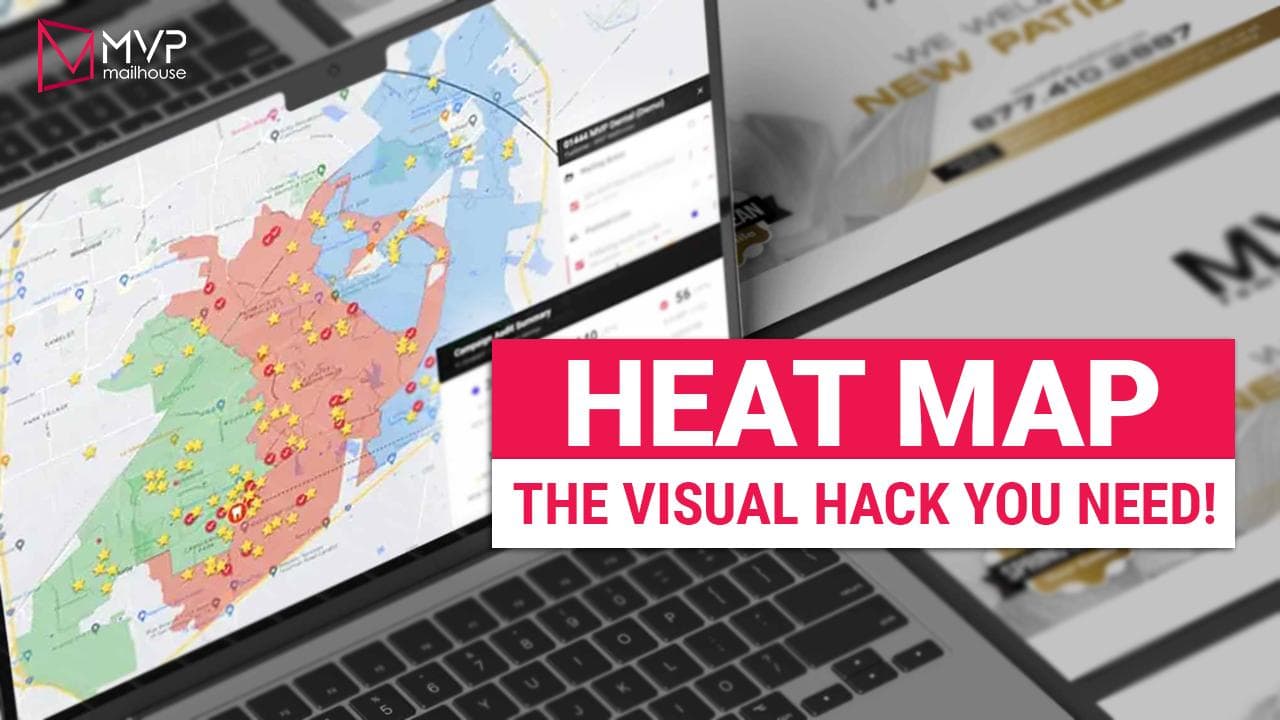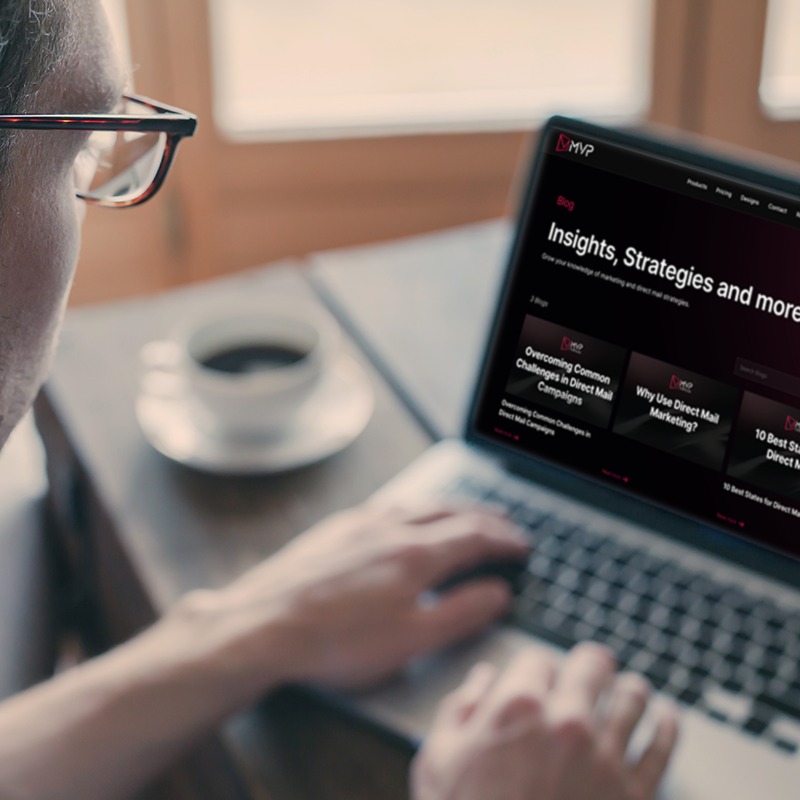What is a Heat Map in Marketing?
Learn what a heat map is and how it can boost your marketing! Gain actionable insights to enhance engagement and conversions. Click to read more!

Understanding customer behavior is the heartbeat of successful marketing. One powerful tool that helps marketers visualize and interpret this behavior is the heat map. Whether applied to websites, emails, or even direct mail marketing, heat maps provide a visual representation of how audiences interact with different touchpoints. Before diving into how they work or what they are used for, let’s first break down what a heat map actually is.
What is a Heat Map
A heat map looks simple. Just colors on a screen. But it does more than decorate, it shows patterns in data. Warm colors like red or orange mean high activity. Cool colors like blue or green mean low activity. With one glance, you can tell what grabs attention and what people ignore. No spreadsheets. No endless reports. Just a clear picture.
In marketing, this is powerful. Why? Because it connects what users do with how your site performs. Imagine running an online campaign. A heat map shows visitors clicking your menu often. But they stop at the hero banner. That’s a clue. Your menu works. The content below? Not so much. You know what to change, maybe rearrange your page, tweak your message, or move your call-to-action.
The real value is speed. Numbers become pictures. Pictures become decisions. You see where users struggle, what they love, and how to guide them better. Want more leads? More sales? Or just smoother browsing? Heat maps help you act fast. They strip away guesswork. They keep you focused on what matters, your users and their experience.
Why Heat Maps Matter in Marketing
Heat maps look simple. Just colors splashed across a page. But don’t be fooled, they’re a marketer’s x-ray machine. They take invisible behavior and make it visible.
Click. Scroll. Hover. Stop. Leave.
Every action becomes a data point. Every data point becomes a story.
And the stories? They answer the questions you care about most:
- Where do people’s eyes land first?
- Which spots grab attention… and which are ghost towns?
- What gets ignored, no matter how bold or bright you make it?
This isn’t trivia. It’s strategy.
A heat map shows you the truth about your site. Maybe that “Buy Now” button is too far down. Maybe the headline you love isn’t the one your audience cares about. With a quick look, the map says: “Here’s the problem. Fix it.”
Take dental marketing as an example. Patients might flock to the page on cosmetic dentistry. They read. They stay. They care. But the appointment form? Buried. Forgotten. Cold.
The fix is obvious. Move the form up. Add a booking button where eyes already linger. Expand the content that keeps people curious. Suddenly, what was passive interest becomes active appointments.
That’s the power of heat maps. They strip away the guesswork. They tell you, plain and simple, what works and what doesn’t. And in marketing, clarity is everything.
A Blend of Science and Strategy
A heat map makes data easy to understand. Instead of staring at endless numbers, bounce rates, clicks, time on site, you see a picture. Bright spots show where people click. Faded areas show where they don’t. It’s quick. It’s visual. And it tells a story at a glance.
Traditional analytics? They can feel like wading through mud. Spreadsheets stacked with stats. Charts that need decoding. Hours spent trying to spot patterns. A heat map skips all that. It shows where users scroll, pause, or get stuck. No guessing. Just clear patterns you can actually see.
This is powerful for businesses with complex services. Take dental marketing, for example. Instead of wondering if patients are reading your service pages, a heat map shows you. Are they stopping at descriptions? Skipping your call-to-action buttons? Dropping out halfway through a form? Now you know.
And once you know, you can act. Fix what’s broken. Highlight what’s working. Adjust the flow so it feels natural. Your website stops being a maze and starts being a guide. The result? A smoother experience for visitors. More trust. More conversions. A marketing approach that’s less mechanical, more human and far more effective.
How Does a Heat Map Work?
Now that we’ve defined what a heat map is and why it matters, let’s dive deeper into how this tool actually functions. The mechanics behind a heat map are fascinating because they transform raw behavioral data into a clear, color-coded visualization that any marketer can understand at a glance.
The Science Behind Heat Maps
Heat maps turn raw user behavior into color. Simple, visual, and fast. They show where people click, how far they scroll, and even where their eyes linger. Instead of sifting through endless data, you see patterns painted across a page.
- Clicks and taps: Every press leaves a mark. Buttons, menus, images, even random empty spots, they all light up. Too many clicks on the wrong thing? That’s confusion. Or maybe opportunity.
- Scroll depth: Do people actually reach the bottom of your page? Often, no. Many drop off halfway. If your best call-to-action hides down low, it may never be seen. That’s wasted potential.
- Cursor movement: A hovering mouse is like a whisper of attention. Users pause, hesitate, hover. Sometimes they look, but don’t act. This shows where interest exists without commitment.
- Eye tracking: The advanced tier. Eyes dart, pause, skip. What grabs attention? What gets ignored? This is design stripped bare, what really works, what doesn’t.
All this activity is layered into one picture. Bright red, orange, and yellow zones scream engagement. Cooler greens and blues fade into silence. The map feels alive. It doesn’t just look pretty, it speaks.
In one glance, you know. You see what pulls users in, what pushes them away, and what gets skipped without a thought. No more guesswork. No assumptions. Just raw, visual truth.
Practical Uses: What Is a Heat Map Used For?
Heat maps are simple, but powerful. They show where people click, scroll, and focus their attention. By turning behavior into color patterns, businesses can spot what’s working and what’s not. The result? Clearer insights, smarter decisions, and smoother experiences.
- Website Optimization: A heat map can reveal the hot spots. Which button grabs attention? Which menu barely gets touched? This data points to what users value most. Teams can then move things around, highlight what matters, cut distractions, and guide visitors straight to the goal.
- Landing Page Testing: Not all pages are created equal. Some hold attention. Others lose it fast. Heat maps make the difference visible. When paired with A/B testing, they show not only which design “wins,” but why it works better. That’s the real edge.
- Email Marketing: Think about newsletters. Do readers click the button? The image? The text link buried in the middle? Heat maps answer these questions at a glance. Suddenly, it’s obvious what gets the click and what doesn’t. Marketers can double down on what’s effective and drop the fluff.
- E-Commerce Performance: Product pages live and die by detail. Shoppers might zoom in on the image, skip the description, and bounce if checkout feels messy. With a heat map, every action is recorded. Businesses see the path to purchase and the points where people fall off. That knowledge changes everything.
- Relationship-Driven Businesses: Take a dental clinic. A heat map might show one button stealing the show: “Book Appointment.” The blog? Barely touched. That’s a clue. The clinic should make scheduling front and center, trimming the rest. The effect is simple but huge: patients get what they want quickly, and trust grows because the process feels easy.
In short: heat maps expose the truth about user behavior. No guessing. Just clear, visual proof of what matters most.
How Does a Heat Map Work on Direct Mail?
When you hear heat map, your mind probably jumps to websites, landing pages, or emails. Right? That’s normal. But here’s the surprise: the same idea works for direct mail. And it’s powerful.
A heat map shows where people’s eyes go first. What grabs them. What they skip over. In print marketing, it’s like a cheat sheet for attention. Marketers use eye-tracking studies, focus groups, or even A/B tests to see which parts of a mailer shine and which parts fade into the background.
Think about it, faces. Bright colors. Arrows. Motion cues. The human eye can’t help but notice them. A smiling person in a photo? A bold red offer box? That’s where the eye lands first. Once hooked, attention flows naturally, headline, discount, phone number. These hot spots are gold.
And then comes the call to action (CTA). Big mistake? Hiding it. You could write the strongest offer “Call Today for a Free Consultation” but if it’s shoved in a dark corner, it dies. Cold. Move it into a hot zone, give it contrast, add whitespace, and suddenly it screams. It’s magnetic.
Take dentistry. Timing is everything. Trust matters. A postcard with “Free Whitening with First Cleaning” placed right in a hot spot? Boom. That’s the kind of offer people notice. Fast. But if it’s lost under clutter? Opportunity gone.
That’s the magic of heat maps. They don’t just make mail prettier. They make it smarter. Strategic. Psychological. Every design choice, tested, optimized, intentional. The payoff? Direct mail that doesn’t just sit in a pile. It works. It moves eyes. It sparks action.
Benefits of Using Heat Maps in Marketing
Heat maps are more than just a diagnostic tool, they’re a roadmap to stronger marketing outcomes. By showing where attention flows and where it doesn’t, they help businesses create experiences that align with real customer behavior instead of guesswork.
Key Advantages of Heat Maps
Improved User Experience
Heat maps shine a light on trouble spots.
They show where visitors pause, get confused, or miss important elements like menus or buttons.
Think of it as a visual guide to user frustration. Once you see the problem, you can fix it. Smooth navigation. Faster clicks. Less irritation. And a much better browsing journey overall.
Higher Conversion Rates
Here’s where heat maps get exciting.
They expose which calls-to-action (CTAs) attract eyeballs and which ones fade into the background.
No more guessing games. You can place buttons, forms, and offers exactly where attention naturally flows. The result? More leads. More appointments. More sales. Simple changes. Big impact.
Smarter Campaign Design
Heat maps aren’t just for websites.
They shape campaigns, too, yes, even offline ones like direct mail. Want to know which design grabs attention? Which headline pulls the reader in? Which visual gets ignored? Heat maps give you the answers. Cut the fluff. Keep the winners. Build campaigns around what works.
Better Decision-Making
Relying on instinct? Risky.
Relying on visuals backed by real behavior? Powerful. Heat maps turn data into a story. A story your marketing team can trust. Every choice, designs, layouts, messages becomes grounded in evidence, not guesswork. That means less risk, faster improvements, and stronger results.
Why It Matters in Competitive Markets
Take dental marketing as an example. Competition is fierce. One tiny edge like a clearer button or smoother user flow, can sway a patient to choose you over someone else. With heat maps, every tweak counts. Engagement goes up. ROI grows. Marketing spend stops being a gamble and starts becoming growth fuel.
Final Thoughts
So, what is a heat map? It’s more than just a colorful chart, it’s a tool that brings customer behavior to life. From websites and landing pages to email campaigns and even direct mail, heat maps provide the clarity needed to make informed, impactful decisions. By understanding how audiences truly interact with your marketing, you can design experiences that not only capture attention but also inspire action.
If you’re ready to optimize your campaigns and see the power of heat maps in action, visit our website today or schedule a demo to explore how we can help transform your marketing strategy.
Tags
Frequently Asked Questions
Related blog



